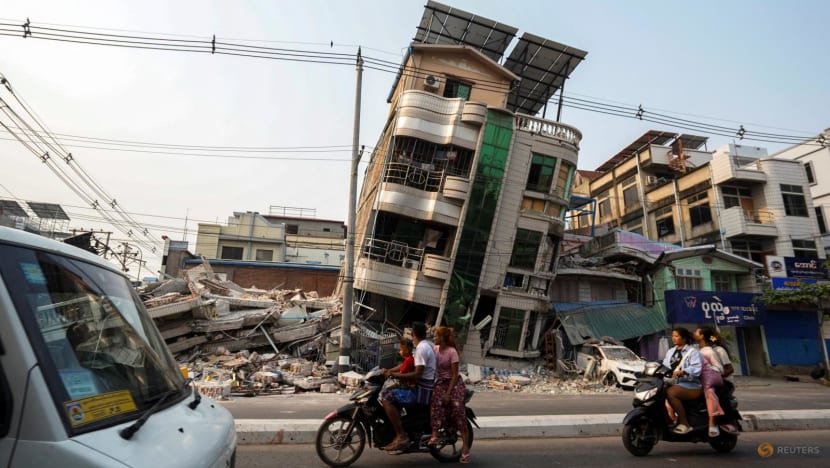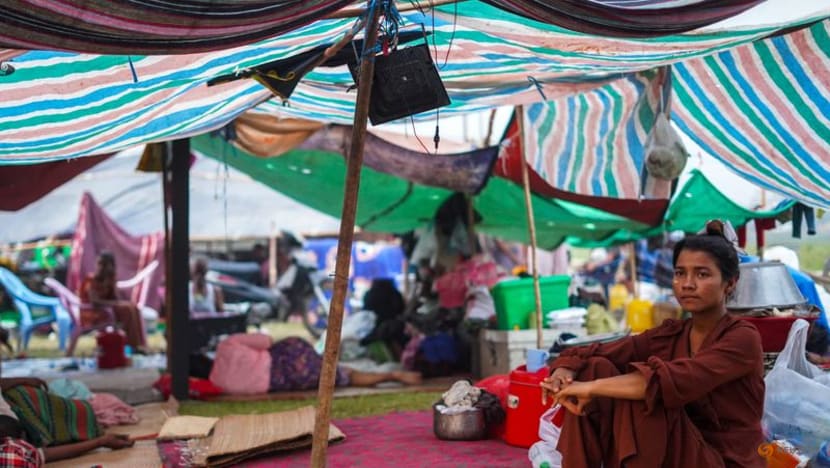For one 13-year-old survivor, Myanmar quake triggers painful memories of Cyclone Mocha
The teenager lost his mother to the cyclone two years ago, and had moved to Mandalay for a fresh start when the quake struck.

People drive past a collapsed building on Mar 30, 2025 in the aftermath of a strong earthquake in Mandalay, Myanmar. (Photo: REUTERS/Stringer)

This audio is generated by an AI tool.
MANDALAY: It was the final Friday prayers for Ramadan, just two days (Mar 28) before the Eid al-Fitr festival marking the end of the Islamic holy month.
A 13-year-old Mandalay resident, who goes by the name Sein, was at a mosque near his home, listening as his Imam preached.
Suddenly, the ground quivered and the mosque shuddered.
“Everybody scattered and ran. When I reached my father, he told me, ‘Don’t run outside, sit still. If we’re going to die, let’s die while praying’,” he recalled.
“So, we continued praying. I suddenly felt as if I was violently pulled by someone… and our mosque seemed to shake back and forth.”
When the tremors stopped, Sein stepped out onto the streets and immediately saw that several nearby shops had collapsed.
The devastating scene triggered a flood of dread and déjà vu for the teenager.
PAINFUL MEMORIES
Less than two years ago, Sein lost his mother and younger brother when Cyclone Mocha brought lashing rain and winds to Rakhine, along Myanmar’s western coast.
The deadly cyclonic storm killed at least 145 people in the country and displaced hundreds of thousands when it made landfall in May 2023.
“I saw the sea levels rise and water flooded everything, including the building where we held out. I had to swim to escape,” he recounted.
His mother was five months pregnant at the time.
“I cried a lot. My mum is truly gone. Mum did everything for our home since I was young,” he said, the pain evident in his voice.
“I prayed to Allah, please send my mum to heaven. If we lose our lives in this earthquake, please send us all to heaven as well, so we can meet her again.”
NEW LIFE SHAKEN BY QUAKE
When the ground finally stopped shaking from the 7.7-magnitude earthquake, Sein rushed back to the apartment he shared with his new family.
By now, his father has remarried and Sein has a younger stepsister. They left Rakhine a year after Cyclone Mocha to start a new life in Mandalay.
As he sprinted past buildings that crumbled in the quake, the knot in his stomach grew tighter.
Thankfully, he found his family safe and sound, albeit shaken by the powerful tremors.
“I suffered the storm. I suffered the earthquake. I don’t want (natural disasters) anymore,” he said.
Scores of mosques across the country sustained damage from the disaster, with grieving worshippers having to observe a muted Eid with prayers on the streets.
HEAVY RAIN SOAK SURVIVORS
Latest figures show at least 3,400 people have died in the powerful earthquake, with over 200 still missing and thousands injured.
A United Nations estimate suggests more than three million people have been affected by the disaster.
Neighbouring China, India and Southeast Asian nations are among those that dispatched relief supplies and rescuers.
But recovery efforts have been hampered by damaged telecommunications and road infrastructure, and a civil war that has already displaced millions.

Unseasonal heavy rains that started pouring on Sunday are further aggravating the humanitarian crisis, beating down on survivors camping in the open and soaking through their belongings.
During the day, the temperature is expected to climb to 37 degrees Celsius this week.
Many residents in quake-hit areas are braving the extreme weather conditions along the streets and on the fields with rickety tents. They are afraid that the walls could crumble in on them during aftershocks if they stayed indoors.
Aid agencies have warned that the combination of rain and high heat could cause outbreaks of disease.
UN APPEALS FOR AID
UN humanitarian chief Tom Fletcher, who recently visited Mandalay and Naypyidaw, called the situation “utterly desperate”.
“It’s a disaster of epic proportions. Lives (have been) completely uprooted and shattered,” he told CNA.
“But I've also seen enormous resilience, (with) communities rallying around, supporting those who've lost everything.”
The ongoing bloodshed triggered by the 2021 military coup has rendered a “tough operating environment” for the UN’s 48 teams on the ground, Fletcher added.
Humanitarian agencies have accused the military junta of blocking the delivery of supplies to areas controlled by rebel groups, with aid workers facing certain dangers.
“The conflict makes it much, much harder. We try to get access to every part of the country. It's vital for us that we can go anywhere and get aid to anyone who needs it. We'll work with local groups in order to do that,” Fletcher said.
Another difficulty faced by aid agencies is a lack of funding, he added, urging the international community to step up support.
NEW FEAR AS CONFLICT CONTINUES
For Sein and his family, they feel lucky to have escaped the earthquake unscathed.
But his father has lingering fears.
He told CNA that the Myanmar military has been asking families if they have eligible members for conscription.
He is terrified that Sein, who has survived two harrowing disasters at such a young age, will be called to pick up arms.
Myanmar's military chief Min Aung Hlaing has recently declared a three-week ceasefire to facilitate quake-recovery efforts.
But already, there have been reports that clashes have resumed with anti-government militia groups.
The violence that has been crippling the country for the past four years has chipped away at many of its citizens’ livelihoods.
Even as quake survivors struggle to rebuild, there are worries the situation could worsen and more of their loved ones could be put at risk.



















